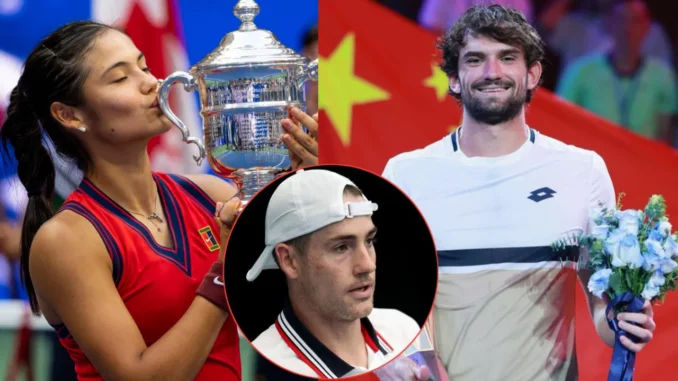
In the electrifying realm of professional tennis, where rankings and seasoned pedigrees typically script the final chapters, a scrappy underdog occasionally storms the stage to flip the narrative into pure magic. That’s exactly what unfolded at the 2025 Shanghai Masters, as Valentin Vacherot—a virtual unknown hailing from the sun-kissed principality of Monaco—left the tennis world slack-jawed by snatching the crown as a lowly qualifier. This jaw-dropping odyssey has ignited fervent debates across the circuit, especially after retired American powerhouse John Isner threw down the gauntlet, boldly proclaiming Vacherot’s saga even more impressive than Emma Raducanu’s legendary 2021 US Open conquest.
Vacherot’s road to immortality kicked off against staggering odds. Sitting at a humble No. 204 when the tournament dawned, the 26-year-old wasn’t even slotted into the qualifying draw proper. It demanded a cascade of withdrawals from higher-ranked hopefuls for him to slip in as the ninth alternate—a true long-shot lottery win. Undeterred, Vacherot bulldozed his two qualifying clashes to crash the main draw, etching his debut at a Masters 1000 outside his familiar Monte Carlo turf. But qualifying was just the appetizer; the main course was a fairy-tale feast. He carved through a murderers’ row of tour stalwarts: Laslo Djere in the opener, then Alexander Bublik, Tomas Machac, Tallon Griekspoor, and Holger Rune in succession. The pinnacle? A semifinal stunner over Novak Djokovic—the 24-time Grand Slam titan and living legend—where Vacherot’s baseline bombs and steely resolve silenced the Serb’s symphony. The finale turned familial fireworks, pitting him against cousin Arthur Rinderknech in a drama-laden showdown that Vacherot clinched for glory. In doing so, he joined an elite trio as only the third man ever to hoist a Masters 1000 trophy straight from qualifiers. His ranking? A rocket ride to No. 40 overnight, catapulting him into ATP’s elite strata and heralding a career supernova.
This rags-to-riches epic naturally summoned ghosts of another qualifier’s miracle: Emma Raducanu’s spellbinding 2021 US Open rampage. Mere months after acing her high school exams, the 18-year-old Brit, ranked No. 150, exploded onto the global stage in her second Slam ever. She blazed through three qualifying sets without surrender, then ravaged the main draw, toppling seeds like Belinda Bencic and Maria Sakkari on her way to the title. Ten straight wins—all in straight sets—capped by a final triumph over Leylah Fernandez, making her the first qualifier, man or woman, to claim a Grand Slam. The feat didn’t just rewrite record books; it unleashed a worldwide media maelstrom, transforming a schoolgirl into an icon.
Enter John Isner, the ex-world No. 8 famed for his cannon serve and epic endurance marathons, who dissected the drama on the Nothing Major podcast with ex-pro pals Sam Querrey, Steve Johnson, and Jack Sock. Pressed on whether Vacherot’s Shanghai miracle topped Raducanu’s Flushing Meadows magic, Isner fired back without pause: “I think it is more impressive, yes. But Raducanu, it’s a bigger story because it’s the US Open. I think this is more improbable than what she did. But her winning the US Open makes it a bigger story, even though this story is really big in the tennis world. I am giving it to Vacherot there. It’s just unheard of.” His verdict? A Molotov cocktail lobbed into fan forums, sparking a wildfire of backlash from Raducanu loyalists.
The uproar was instant and impassioned. Defenders hammered the chasm between events: Grand Slams’ grueling best-of-five men’s format and deeper fields dwarf a Masters’ best-of-three intensity. “Recency bias alert,” one diehard tweeted, stressing that while qualifier Masters wins have precedents (think Hyeon Chung in 2018), a Slam qualifier’s triumph is a one-of-one unicorn. Raducanu’s tender age and zero WTA wins pre-US Open painted her as the ultimate rookie revelation, miles from Vacherot’s battle-hardened 26 years grinding Challengers. Yet Isner’s improbability angle held water—Vacherot’s ninth-alternate entry and Djokovic scalp screamed statistical sorcery.
This clash of titans spotlights tennis’s timeless thrill: underdog tales where mind-over-matter momentum topples titans. Raducanu’s win collided with teen stardom’s cyclone, spawning a post-glory gauntlet of injuries, coach carousel spins, and form funks that she’s still navigating. Brilliant sparks—like her grass-court fireworks—dot her path, but no major encore amplifies her 2021’s mythic aura. Vacherot, a late-bloomer from Monaco’s luxe lanes, feasted on Challenger circuits before this eruption. His Djokovic dissection? A cocktail of thunderous groundies and zen calm that screams top-20 destiny. Post-Shanghai, he’s already eyeing Indian Wells and Miami, where sustained fire could land him seeds and showdowns with the Big Three remnants.
But let’s zoom out: these sagas aren’t rivals—they’re twin beacons of tennis’s inspirational core. Vacherot’s grind whispers that fringe fighters can feast with fortune; Raducanu’s burst celebrates youth’s wild-card wonder. Isner nailed it on stage scale—a Slam’s coliseum roar outshines a Masters’ spotlight—yet Vacherot’s nine-match streak, dodging absences but slaying Djokovic, is pure perseverance porn. Imagine the locker-room lore: Vacherot’s cousin final, Raducanu’s exam-to-champ dash—both fuel for future phenoms.
Ultimately, stacking these gems misses the mosaic. Tennis pulses with qualifier-to-king moments that ignite endless chatter, keeping the sport’s soul alive. Back Isner’s audacious edge or rally for Raducanu’s romance? Either way, these quests prove fairy tales aren’t fiction—they’re forged on clay, grass, and hard courts. As the ATP odyssey rolls on, Vacherot hunts consistency to cement his surge, while Raducanu battles back to elite echelons. The real rapture? The unknown ahead, and the debates that never die. In tennis, every underdog’s whisper could be the next roar.
Leave a Reply